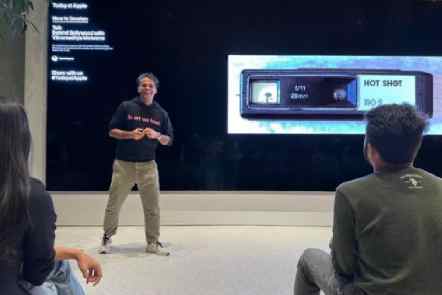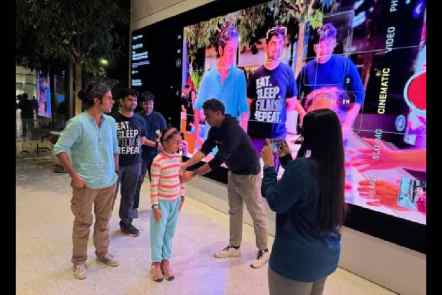The film Tangerine, directed by Sean Baker, was striking enough to make the viewer feel that they are on the streets of Los Angeles with the film’s main characters. Baker used the iPhone 5s to shoot the 2015 film. Since then, the iPhone has matured quite a lot and filmmaker Vikramaditya Motwane knows this well.
He was at Apple BKC, the company’s first offline store in India, a few weeks ago to conduct a Today at Apple session where he spoke on the role played by technology, including the iPhone. Later, we caught up over a phone call to touch upon various aspects of Apple devices.

Filmmaker Vikramaditya Motwane addresses the crowd at a Today at Apple session at Apple BKC in Mumbai
“It was a good experience. At some level, there’s a massive familiarity with Apple, because I’ve been a fan of Apple for a long time. Not only their phones, also their laptops… from an editing standpoint, being able to use stable hardware to edit stuff. I give credit to Apple products to be able to allow… in a sense give me stability to practice with software and hardware,” said the man behind titles like Udaan, Lootera and AK vs AK.
He grew up in an era when the Internet had just entered India. “It was kind of talking about things that I knew about. I am very tech-friendly, I love tech. I’ve learned so much of my tech through the Internet. Growing up in that sort of… a bridge between analogue and digital worlds, the discovery of the Internet... and it was very interesting because we were tech geeks in an analogue world. It gave me an opportunity to go into my archive and see all the photos I have taken in the past,” said Motwane.
‘You have the tool in your hand’
Looking at Sean Baker’s film from 2015 and, say, Vishal Bhardwaj’s Fursat, shot on the iPhone 14 Pro, the device has come a long way. It’s not that spcialised cameras will ever go away but the approach to filmmaking is changing.
“Eventually, the classic motion picture cameras are specialised and the sensor size on those is much bigger. Those are spcialised cameras that offer far more latitude. But today, you can also shoot a film with the iPhone. It’s only a trained eye that can tell the difference between an iPhone and something that’s been shot on a much larger professional camera. And that is a huge leap for the iPhone. You’ve now got multiple lenses in the Pro model… you have the tele(photo) lens, which has incredible image stabilisation… it’s great for students. If you’re happy with the iPhone look then it’s a great camera,” said the filmmaker.
If you look at the early days of the iPhone, many users were impressed by the photography capabilities it offered. They started nurturing the photographer inside them and eventually, some, went on to buy more expensive cameras to pursue a dream. The same is happening with videos now. “I think for younger photographers and filmmakers the best camera is the one that’s in your pocket. Not only can you shoot using an iPhone, you can process, share and do everything on one device. When we were making films as students or as young filmmakers, we had to rent a camera and then an editing studio. All of that can literally be done between a phone and a laptop. And it doesn’t even need to be specifically Apple. Also between an iPhone and a Mac, or right now with an iPhone or an iPad, or even like only on an iPhone itself, you can pretty much shoot, edit, create, do whatever you want and put it out there. That learning is something I kept talking about during the (Today at Apple) session and about how important it is to practice. For a filmmaker, you have to practice photography and you have to practice making movies. That is something you can do with an iPhone. It’s not like the machine is going to magically do everything; it’s up to you to write something and shoot something. You have the tool in your hand. There is no need for you to go out and get the tools; it’s in your pocket.”
‘The first step is to have a good script’
Being a filmmaker, his go-to device is the Mac because it helps in the video editing process. Final Cut Pro is, of course, one of the best in the industry but there are options. “I started using Final Cut Pro on the iMac and the fantastic thing about the software is that it’s extremely stable. Even though I was using an underpowered laptop to be able to run a proper editing software, it was stable, it wouldn’t crash or burn. I think that is something that really helps when I’m using Final Cut Pro, whether it’s for short films or videos, and I think that has carried on even though the software of choice has changed… I also use Avid and Premiere Pro, but I’m always using my Mac, be it a MacBook Pro or an iMac or Mac Mini. There’s always the stability of hardware.”
Having the best devices, of course, won’t help make the best films. The main tool for a filmmaker is story and that’s something Motwane wants every aspiring filmmaker to remember. “The first step is to have a good script. And beyond that it really depends on what you’re trying to say, who your audience is and what your budget is. Everything will fall into place based on those things. The iPhone is an interesting tool. Steven Soderbergh has shot an entire feature film (Unsane and High Flying Bird), so has Sean Baker. I have shot about 50 per cent of my next film on an iPhone. If you are happy with the look, go for it. Have a great script and then go about it. One tool is not going to solve everything. You won’t go about using an iPhone to shoot for an IMAX screen. It all depends,” says the 46-year-old director.
Well, well, well… a film on the iPhone? “We actually shot a part of it on the iPhone 14 (since the project unfolded before the release of the iPhone 15 series). We were very surprised by the level of detail, especially when you shoot 4K. If you look at the new USB-C iPhone (15), a lot of the monitoring issues have been taken care of. I think every year it’s going to get more surprising. Image stabilisation is fantastic and so is colour rendition.”

The man behind titles like Udaan, Lootera and AK vs AK speaks to young members in the audience at Apple BKC
The iPhone 15 Pro Max comes with the equivalent of seven pro lenses. You get macro, 13mm ultra-wide f/2.2, 24mm f/1.78 main camera, a 28mm and 35mm FOV shift from that main camera, the 2x 48mm equivalent FOV from the previous iPhone, and finally either 77mm f/2.8 on the iPhone 15 Pro or the new 120mm f/2.8 which comes only on the iPhone 15 Pro Max. You can use any of these cameras.
“I haven’t used it (iPhone 15) in a professional setting. So far I have been using the iPhone 15 mostly for photography and stills. I’m been super-impressed with the 120mm lens. I think it’s fantastic. The jump from one to 5x… is great. And one can zoom in Cinematic mode. It’s dramatic and it continues to improve. Look at the Portrait mode and where it is now. When it first appeared, it felt like computational photography but now it’s very nice. You have a lot of control over the process. Cinematic Mode is going that way. It’s a great tool.”
For the time being, Motwane is busy indulging in his favourite hobby — watching films with his family. “I’m dying to watch David Fincher’s The Killer. He is among my favourite filmmakers. So that’s what I’m most excited about.”











